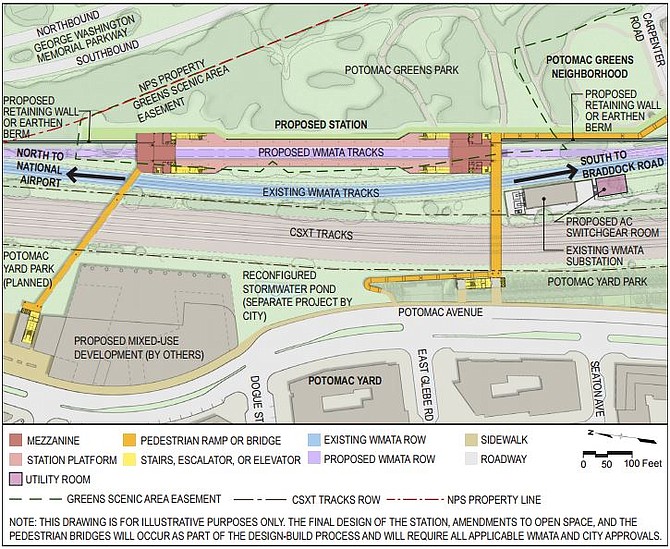After years of planning, Potomac Yard Metro is starting to come together. But for many local residents, the arrival of the new Metro station comes with some remaining hurdles.
The ongoing Potomac Yard Metro Station development received two major updates in the first week of June. The first was the release of the Potomac Yard Metrorail Station final Environmental Impact Statement. The document summarizes the potential impacts on the nearby neighborhoods and parks. The second update was the approval of a master plan amendment, a zoning change, and three development special use permits (DSUP) at the June 7 Planning Commission meeting. The changes approved at the Planning Commission divide and rezone portions of Potomac Yard and Potomac Greens to be utilized for the purposes of Metro construction.
Several citizens from Potomac Yard and Potomac Greens spoke at the meeting and expressed concerns Planning Commission Chair Mary Lyman summarized as those centered around the cost of the station and the traffic impact on the local neighborhood. Given that the most recent Metro station construction, NoMa-Gallaudet U in northeast D.C. overran its initial construction budget by 37 percent, some residents expressed concerns that city staff’s project cost overrun only planned for up to 15 percent. Lyman said she heard and recognized the cost concerns, but that those were issues better handled by the City Council than the Planning Commission.
When asked for a specific number for the cost of the project, Mitch Bernstein, director of Project Implementation, said that the full cost of the project won’t be known until the city settles on a construction bid.
The Environmental Impact Statement compared the effects of the no-build alternative to the preferred alternative, Alternative B selected by City Council in May 2015. While the two updates are mostly unrelated, the Environmental Impact Statement provided some of the answers to questions raised at the Planning Commission meeting. The estimate of capital costs for the Potomac Yard project range from $160 million to a high of $316 million. The cost to the city is to be funded by projected net new tax revenues near the station, two special tax districts in Potomac Yard, and contributions from developers.
Poul Hertel, a resident of Fairfax, raised concerns about the station’s impact on views from the George Washington Memorial Parkway, both in a discussion during the Planning Commission meeting and in an extensive letter detailing the history and purpose of the parkway. Hertel accused the city of pressuring the federal government into acquiescing to the impacts of the station on the parkway view.
The Environmental Impact Statement noted that there would be impacts on the views from the George Washington Memorial Parkway, but also noted that the development makes efforts to mitigate that impact.
“The Preferred Alternative would impact views from the George Washington Memorial Parkway … due to the introduction of new visual elements and removal of vegetation for construction access and staging areas,” according to the Environmental Impact Statement. “New visual elements include the station and pedestrian bridges. Under Station Design Option 1 for the Preferred Alternative, the new visual elements would also include retaining walls adjacent to the realigned tracks.”
Resident Rafael Lima expressed concerns that the station could have a negative impact on parking in the neighborhoods. Lima was particularly concerned that the city’s response seemed reactive. There are currently no parking restrictions on the streets closest to the Potomac Yard Metro station. The report on the project says that, under city regulations, the problem has to be shown to exist before the city will amend parking condition requirements. For local residents, this means the Metro station’s effect on parking will have to take place before anything can be done to keep the Metro station from impacting local parking. To change parking conditions, 75 percent of parking spaces in the neighborhood must be occupied, 25 percent of that occupation by non-residents of the proposed district.
This parking issue is made worse by the fact that, being classified as a transit station, there is no requirement for parking in the city’s zoning ordinance.
“During the early planning stages for the Metrorail station, a decision was made to make this an urban station with no designated parking, and no designated drop-off area or Kiss and Ride,” said the report. “While some vehicular drop-off will likely occur, the design tries to discourage this by not including a designated or convenient drop off area.”
Planning commissioners expressed similar concerns about parking, but it was not enough to deter the commission from a unanimous vote in favor of the changes. Commissioner David Brown questioned the feasibility of not having drop off access, but said that this was the kind of change staff can continue to look at as the design goes forward.
“But that’s all part, in my mind, of fine tuning an implementation that has to come down the road,” said Brown. “I have heard nothing tonight that in any way shakes my confidence that staff has done a thorough job here. A lot of what I’ve heard from the community is still stuff that can be addressed down the road that we can still revisit as appropriate.”

